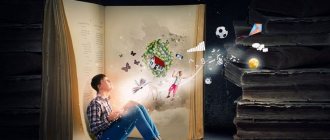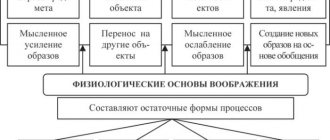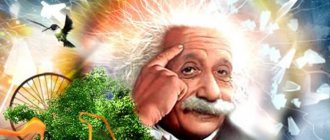Imagination is the ability of the psyche to create images in consciousness. All processes that occur in images are called imagination. Imagination as a mental process constitutes visual-figurative thinking, thanks to which a person can navigate and search for solutions to problems without the direct intervention of practical actions. This process is very important, especially in cases where it is impossible or difficult to carry out the required practical action, or it is simply impractical.
This process reflects the human world around us at higher mental levels. The most popular definition of imagination is a mental process, the essence of which is the creation of new unique images through the processing of the perceived material of ideas that came with previous experience. It is also considered as a phenomenon, as an ability and as a specific activity of the subject. This process has a complex functional structure, so Vygotsky defined it as a psychological system.
The function of imagination is unique to humans and has a certain significance in a person’s specific professional activity. Before embarking on a certain activity, he imagines what the object will look like and mentally creates an algorithm of actions. Thus, a person constructs in advance an image of a future object or the final result of an activity. Developed creative imagination plays a great role in creative professions. Thanks to their developed creative abilities, people earn a lot of money.
There are several types of imagination: active (voluntary), passive (involuntary), recreative, creative.
Imagination in psychology
Imagination is the process of understanding the world around us. The outside world seems to be imprinted in a person’s subconscious. Thanks to this, a person is able to remember ancient and recent events, program, and imagine the future. This process is often called the ability to imagine absent objects in one’s mind, hold their image, and manipulate it in consciousness. Sometimes it is confused with perception, but they are really two different mental processes.
Imagination has the ability to create images based on memory, and not on information from the outside world. It is less real because it has a component of fantasy and dreams. Even the most pragmatic, skeptical, boring people have imagination. It is impossible to assign a person who has completely lost such a function. The behavior of these people is governed by their principles, logic, facts, they always do everything according to the rules. But to say that they have no creative thinking at all or that they never dream is very wrong. It’s just that this is the type of people in whom these processes are not sufficiently developed or they do not use them, or do not know how to use them. Often such people have a monotonous typical life, which is repeated the same way every day, and they act according to a certain algorithm, believing that they do not have time for more. In fact, it is a pity for such people, because their life is boring, they do not use the abilities that are given to them by nature. Creative imagination makes people individual, unique individuals.
Imagination as a mental process has certain functions that help a person become special.
The cognitive function is contained in expanding a person’s horizons, acquiring knowledge, constructing human behavior in an uncertain situation, guided by guesses and considerations.
The prediction function assumes that the properties of imagination help a person imagine the final result of an incomplete action. It is this function that contributes to the formation of dreams and daydreams in people.
The function of understanding is reflected in a person’s ability to guess what a person is currently experiencing, what emotions are overwhelming him, what feelings he is experiencing. Similar to this function is the state of empathy, when a person is able to penetrate into the world of another and understand what worries him.
The protection function assumes that by predicting future events, thinking about the course of actions and the consequences of these actions, a person can prevent troubles and protect himself from possible problems.
The function of self-development is reflected in a person’s ability to fantasize, invent and create.
The function of memory is expressed in a person’s ability to remember past events and recreate images of the past in his head. It is stored in the form of images and ideas.
The above functions are not always fully expressed in all people. Each personality is dominated by a certain function, which often determines the character and behavior of a person. To understand how images and ideas are created, it is necessary to trace the main ways of their creation. Each path is a complex multi-level mental process.
Agglutination is the creation of unreal, completely new, fabulous objects or phenomena that appear under the influence of the properties and appearance of some existing object, evaluating and analyzing the properties of which a person creates an object similar to it. That is, there is an initial object on the basis of which a prototype is formed. This technique is very popular in creating fairy tales or myths.
Emphasis is the process of fixing on one dominant characteristic highlighted in some object (person, object, activity, phenomenon) and exaggerating it. Artists often use accentuation in their works to create cartoons and caricatures.
Typification is the process of identifying the main characteristics in several objects, and creating from them an image that is completely new, but contains a piece of each of them. Using this technique, literary heroes and characters are created.
All of the above imagination techniques are actively used in psychology, creativity, and even scientific activity. For example, in medicine, new drugs are created based on existing ones. Also, modern technology, electronics, gadgets, inventions were developed on the basis of previously existing knowledge, schemes, theories and skills. By collecting the most important information from them and processing it, scientists get a completely new product. If people lacked imagination, humanity would not be able to progress in all areas and activities.
Imagination as a mental process involves the creation of new images based on existing existing experience. The ideas manifested in images in a person’s head have not yet begun to be realized, do not exist, but there is a possibility that in the future they can be brought to life. This process is based on the reformulation of the subject’s information and impressions. The more the situation seems incomprehensible and complex, the more the imagination process is involved. This process is of considerable importance in human professional activity. It also greatly influences feelings and emotions, and plays a big role in personality development.
In the creative and work process, imagination allows the individual to regulate and manage her activities, as well as control her speech, emotions, attention and memory. Helps create and use images of reality. It improves a person’s psychological state, prevents stress and depression. With the help of imagination, an individual is able to plan his future activities in his mind by manipulating images. Imagination and individuality are criteria for assessing a person’s talent and abilities, which is important in work life.
A person reflects the surrounding reality mainly in a figurative way. An image is a non-static phenomenon; it tends to constantly change. This process has a dynamic connection with the objects of the surrounding reality. Consequently, imagination is not some kind of abstraction, but a concrete process associated with the real mental activity of the subject. This activity is also dynamic in nature.
Imagination is the process of self-knowledge of a person, the disclosure of his abilities, other people and the world around him, and the events taking place. This is a special form of the human psyche, occupying a place between perception, memory and thinking processes. Visual-figurative thinking and imagination complement each other; imagination is its basis and makes it possible to show resourcefulness in an unfamiliar situation, to find a solution to a problem without using any action.
Types of imagination
This process, as a complex mental process, also comes in several types. Regarding the features of the process, they distinguish: involuntary, voluntary, recreating, creative, and daydreaming.
Involuntary imagination is also called passive imagination. This is the simplest type and it consists in creating and combining ideas, their components into a new image, when a person does not have a direct intention to do this, when consciousness is weak, and control over the flow of ideas is small.
Passive imagination occurs in young children. It manifests itself most often when a person is in a drowsy, half-asleep state, then images appear on their own (therefore arbitrary), some change to others, they combine, take on the most unreal forms and types.
Such imagination operates not only in a sleepy state, it also manifests itself in a waking state. New ideas do not always appear when a person purposefully directs his consciousness to creation. A feature of the created images is their variability as a result of the instability of trace excitations of the brain and the ease of their interconnection with excitation processes in adjacent brain centers. Because the trajectory of arousal is not fixed, this makes imagination so easy. It is especially easy in children, who also lack critical thinking, which acts as a filtering mechanism in adults, so the child sometimes produces the most unrealistic, fantasized images. Only by acquiring life experience and forming a critical attitude, such unintentional imagination is gradually put in order and guides the consciousness, therefore a deliberate active idea is formed.
Voluntary imagination, also called active, is the deliberate construction of ideas according to the task at hand in a certain activity. Active imagination develops when children begin to play roles (doctor, salesperson, teacher). When they try to portray their role, they have to use their brains as accurately as possible, thus using their imagination. Further development of this process occurs when a person begins to act independently, shows initiative and creative efforts in the process of work, requiring clear and accurate representations of the subject that will be created from operations and which must be performed.
Active imagination is most manifested in human creative activity. In this process, a person sets himself a task, which is the starting point for the development of the imagination process. Since the product of this activity is objects of art, the imagination is governed by the requirements that follow from the specific characteristics of art.
The re-creating aspect of this process is that a person must create an image of an object that he has never seen, based on certain descriptions.
Recreating imagination, according to its psychological structure, is the translation of a second-signal stimulus into a re-signal image.
Recreative imagination embraces the creation of something that already exists and how it exists. It is not separate from reality, and if you move away from it a little, then the imagination will not correspond to the goals of cognition - to expand the field of human knowledge, reducing descriptions to visual images.
Recreating imagination helps a person to be transported to other countries, into space, to see historical events and objects that he has never seen before in his life, but can imagine after recreating. This process allows people who read works of fiction to recreate pictures, events and characters in their heads.
Creative imagination is also considered an active imagination; it is involved in the formation of new images in creative activities, art, science, and technical activities. Composers, writers, and artists use this process to depict life in images in their art. They create artistic images through which they reflect life as truthfully as possible, rather than photographically copying life events. These images also reflect the individuality of the creative person, his approach to life, and artistic style.
Creative imagination is also used in scientific activity, which cannot be interpreted as ordinary mechanical knowledge of phenomena. Building hypotheses is a creative process, which is then confirmed by practice.
There is another unique type of this process - this is a dream, as a representation of what is desired in the future. It is created in a meaningful way, as opposed to unintentional daydreaming. A person consciously directs his thoughts to the formation of desired goals, planning strategies to achieve these goals and translating them into real life.
Daydreaming can be useful, but it can also be harmful. When a dream is transcendental, unrealistic, and unrelated to life, it weakens a person’s will, reduces his activity and slows down psychological development. Such dreams are empty, meaningless, they are called dreams. When a dream is connected with reality, and potentially real, it helps a person to mobilize, unite efforts and resources to achieve a goal. Such a dream is an incentive for active action and the rapid development of the best qualities of an individual.
How to write a term paper on speech therapy
07.09.2010 244888
These guidelines are compiled to help students gain an understanding of the content and structure of coursework in speech therapy.
Logopedia of pedagogical science that studies anomalies of speech development with normal hearing, explores the manifestations, nature and mechanisms of speech disorders, develops the scientific basis for overcoming and preventing them means of special training and education.
The subject of speech therapy as a science is speech disorders and the process of training and education of persons with speech disorders.
The object of study is a person suffering from a speech disorder.
The main task of speech therapy as a science is the study, prevention and elimination of various types of speech disorders.
Coursework in speech therapy is a student's scientific and experimental research. This type of educational activity, provided for by the educational and professional program and curriculum, contributes to the acquisition of skills in working with literature, analyzing and summarizing literary sources in order to determine the range of insufficiently studied problems, determining the content and methods of experimental research, processing skills and qualitative analysis of the results obtained. The need to complete coursework in speech therapy is due to the updating of knowledge concerning the content, organization, principles, methods and techniques of speech therapy work.
As a rule, during their studies, students must write two term papers - theoretical and practical.
The first course work should be devoted to the analysis and synthesis of general and specialized literature on the chosen topic. Based on this analysis, it is necessary to justify and develop a method of ascertaining (diagnostic) experiment.
In the second course work, it is necessary to provide an analysis of the results obtained during the ascertaining experiment, as well as determine the directions and content of speech therapy work, and select adequate methods and techniques of correction.
So, let’s present the general requirements for the content and design of coursework in speech therapy.
The initial and most important stage of working on a course project is the choice of a topic, which is either proposed by the supervisor or chosen by the student independently from a list of topics that are consistent with the areas of scientific research of the department.
Each topic can be modified, considered in different aspects, but taking into account a theoretical and practical approach. Having chosen a topic, the student needs to think through in detail its specific content, areas of work, practical material, etc., which should be reflected both in the formulation of the topic and in the further construction of the study. It should be recalled that the chosen topic may not only have a purely theoretical orientation, for example: “Dysarthria. Characteristics of the defect”, “Classification of dysgraphia”, but also take into account the practical significance of the problem under consideration, for example: “Speech therapy work on speech correction for dysarthria”. It should also be taken into account that when formulating a topic, excessive detail should be avoided, for example: “Formation of prosodic components of speech in preschoolers of the sixth year of life attending a preschool institution for children with severe speech impairments.”
The course work includes such mandatory parts as: introduction, three chapters, conclusion, bibliography and appendix.
The text of the term paper begins with the title page . An example of its design can be seen here.
Then the content of the work is given, in which the names of chapters, paragraphs, and sections are formulated in strict accordance with the content of the thesis. An example of its design can be seen here.
In the text, each subsequent chapter and paragraph begins on a new page. At the end of each chapter, the materials are summarized and conclusions are formulated.
The introduction reveals the relevance of the problem under consideration in general and the topic being studied in particular; the problem, subject, object, and purpose of the study are defined. In accordance with the goal and hypothesis, objectives and a set of research methods aimed at achieving the objectives must be defined.
The relevance of the topic lies in reflecting the current level of pedagogical science and practice, meeting the requirements of novelty and usefulness.
When defining the research problem, it is important to indicate what practical tasks it will help to implement in training and educating people with speech pathology.
The object of research is understood as certain aspects of pedagogical reality, perceived through a system of theoretical and practical knowledge. The ultimate goal of any research is to improve this object.
The subject of research is some part, property, element of an object, i.e. the subject of research always indicates a specific aspect of the object that is to be studied and about which the researcher wants to gain new knowledge. An object is a part of an object.
You can give an example of the formulation of the object, subject and problem of research:
– The object of the study is the speech activity of preschool children with phonetic-phonemic speech disorders.
– The subject of the study is the features of intonation speech of children with phonetic-phonemic speech disorders.
– The research problem is to determine effective directions for speech therapy work on the formation of intonation expressiveness of speech in the system of correctional intervention.
The purpose of the study contributes to the specification of the object being studied. The goal of any research is to solve a specific problem. The goal is specified in tasks taking into account the subject of research.
The research objectives are formulated in a certain sequence, which determines the logic of the research. The research objectives are set on the basis of a theoretical analysis of the problem and an assessment of the state of its solution in practice.
The first chapter is an analysis of literary sources, which examines the state of this problem in historical and modern aspects, and presents the most important theoretical principles that formed the basis of the study.
When writing the first chapter, you should pay attention to the fact that the text of the course work must be written in a scientific style. When presenting scientific material, it is necessary to comply with the following requirements:
– Specificity – a review of only those sources that are necessary to disclose only a given topic or solve only a given problem;
– Clarity – which is characterized by semantic coherence and integrity of individual parts of the text;
– Logicality – which provides for a certain structure of presentation of the material;
– Reasoning – evidence of thoughts (why this and not otherwise);
– Precision of wording, excluding ambiguous interpretation of the authors’ statements.
A literary review of the state of the problem being studied should not be reduced to a consistent presentation of literary sources. It should present a generalized description of the literature: highlight the main directions (currents, concepts, points of view), analyze in detail and evaluate the most fundamental works of representatives of these directions.
When writing a work, the student must correctly use literary materials, make references to the authors and sources from which the results of scientific research are borrowed. Failure to provide required references will reduce your coursework grade.
As a rule, in coursework on speech therapy, references to literary sources are formatted as follows: the number of the cited source in the general list of references is placed in square brackets. For example: General speech underdevelopment is a speech pathology in which there is a persistent lag in the formation of all components of the language system: phonetics, vocabulary and grammar [17].
When using quotations, in square brackets, in addition to indicating the source number, the page number from which this excerpt is taken is indicated, for example: Speech rhythm is based on a physiological and intellectual basis, since, firstly, it is directly related to the rhythm of breathing. Secondly, being an element that performs a communicative function, “correlates with meaning, i.e. controlled intellectually” [23, P.40].
However, course work should not be of a purely abstract nature, so you should not abuse the unreasonable abundance of citations. Quoting should be logically justified, convincing and used only when really necessary.
In the second chapter , devoted to experimental research, the organization should be described and the program of the ascertaining experiment should be presented. The survey methodology, as a rule, consists of a description of several series of tasks, with detailed instructions, visual and lexical material, the procedure for completing tasks by experiment participants, and scoring criteria. This chapter also provides a qualitative and quantitative analysis of the results obtained.
When analyzing the results of an experiment, it is necessary to use a scoring system. Examples of various criteria for quantitative and qualitative assessment are presented in the following works:
– Glukhov V.P. Formation of coherent speech in preschool children with general speech underdevelopment. - M.: Arkti, 2002. - 144 p.
– Fotekova T.A. Test methodology for diagnosing oral speech of primary schoolchildren. - M.: Arkti, 2000. - 56 p.
– Levchenko I.Yu. Pathopsychology: Theory and practice. - M.: Academy, 2000. - 232 p.
In order to visually present the results obtained during the experimental study, it is recommended to use tables, graphs, diagrams, etc. Histograms can be used in a variety of ways - columnar, cylindrical, planar, volumetric, etc. An example of the design of tables, figures, and histograms can be found here.
The third chapter provides a rationale for the proposed methods and techniques and reveals the content of the main stages of correctional work.
The conclusion contains a summary of the material presented and the main conclusions formulated by the author.
The bibliography must contain at least 25 sources. The list includes bibliographic information about the sources used in preparing the work. An example of its design can be seen here.
In the application you can present bulky tables or illustrations, examination protocols, observation records, products of activity (drawings, written works of children), notes from speech therapy classes, etc.
The volume of one course work must be at least 30 pages of typewritten text.
In general, coursework in speech therapy is the basis for a future thesis, in which the study of the begun problem can be continued, but from the standpoint of a different approach or a comparative analysis of the disorders being studied in different age categories of people with different types of speech disorders.
The content and format of theses in speech therapy can be found here.
Literature:
1. How to write a term paper on speech therapy: Methodological recommendations. Educational and methodological manual / Comp. Artemova E.E., Tishina L.A. / Ed. Orlova O.S. – M.: MGOPU, 2008. – 35 p.
2. Research work of students in the system of higher professional pedagogical education (specialty 031800 - Speech therapy). Methodological recommendations for completing the thesis / Compiled by. L.V. Lopatina, V.I. Lipakova, G.G. Golubeva. - St. Petersburg: Publishing house of the Russian State Pedagogical University named after. A. I. Herzen, 2002. - 140 p.
Imagination and creativity
Creativity is the process of creating fundamentally new or improved methods for solving tasks and problems. It becomes obvious that imagination and the creative process are very interconnected.
Imagination here is defined as the transformation of ideas about reality and the creation of new images on this basis. It works every time a person thinks about some object or phenomenon, without even coming into direct contact with it. Thanks to creative imagination, the transformation of this idea is carried out.
Creative thinking and imagination have their own specific characteristics. Through this process, it is possible to create completely new, unique representations based on the subject's own ideas and thoughts, which express the personality of the creator. It can be voluntary or involuntary. To a large extent, creative imagination or inclination towards it is determined from birth, but it can also be developed.
The development of creative imagination occurs in three stages. At first, a creative idea arises. In the mind of the creator, a fuzzy image first appears, an initial idea that can be created arbitrarily, without purposeful comprehension of the idea. The second stage involves hatching a plan. A person thinks about strategies for translating an idea into reality and mentally improves it. The third stage completes the incubation of the idea and brings it to life.
The development of creative imagination is carried out in the process of transition from involuntary to voluntary, from recreating to creative. During childhood and adolescence, creative imagination has characteristic features; it is special for its magic, fantastic judgments about the world and the absence of a critical component of thinking and rationality. During adolescence, complex changes occur in the body, and therefore in consciousness as well. Objectivity is developed, perception becomes more critical. Rationality of perception appears a little later, when a person becomes an adult. The adult mind begins to control the imagination, often too much criticality and practicality weakens the processes of fantasy, overfilling them with meaning, loading them with some kind of information that is actually unnecessary.
There are certain methods for developing creative thinking. The most practical method is to read literature and watch scientific films, expand the range of your knowledge, draw knowledge from different areas of life, memorize and analyze information. In this case, a large amount of materials for creative processes appears.
Imagine imaginary objects, try to carry out various manipulations with them. For example, imagine the sea, hear the sound of breaking waves, feel the breath of sea freshness, imagine entering the water, feel its temperature, and so on. Or another example, imagine a pear. Imagine its shape, size, color. Use tactile perception, imagine it when it is in your hand, feel its surface, aroma. You can mentally take a bite of it and imagine the taste.
In order for the imagination to be voluntary, it is necessary to work on it through regular training. To make the effect even greater, you need to look for sources of inspiration, ask friends for help, and ask about their ideas. Try group work to create ideas, sometimes the results are very unique, and a person becomes more active if the process of imagination occurs in a circle of other creative individuals.
Exercises
For creative thinking, it is important to be able to find connections between already acquired experience and what we are contemplating at the moment, in other words, to build associations. The exercises below are aimed at developing imagination and associative thinking.
Exercise 1. Rotating shapes
This exercise is aimed at training the imagination. Its use in the development of imagination was proposed in the 1980s by the famous psychologist Roger Shepard. In each task, you will be shown 2 figures: some are obtained by reflecting each other, others by rotation, and others are simply similar and are not rotation and reflection of each other.
You need to read the question, look carefully at the figures, try to mentally reflect and rotate the figures in your imagination and understand whether they are the same.
Statistics Full screen
Exercise 2. Solving doodles
Droodles
- These are simple pictures, the image on which can be interpreted in different ways. To train your imagination with the help of doodles, you need to give as many answers as possible to the question: “What is shown in the picture?” Also, to develop your imagination as part of increasing your creativity, try to find a meaning for the picture that does not immediately come to mind. You can see all droodles with answers and comments on this page.
Exercise 3. Letter (test)
Within a minute, try to name as many things as possible that are now in the room with you and begin with the letter: “K.” The letter “P”... And the letter “B”?
Count how much you got. If you try, you can name more than 50 things, or even more than 100. To improve this exercise, think about what groups of surrounding objects you forgot to include. For example, starting with the letter “B” you can name:
- things, hanger, (items),
- screws, introduction in the book on the shelf, (details of objects),
- tungsten lamp filaments, felt, cotton wool, viscose, etc. (materials),
- pile on the carpet, wax on the parquet (coating),
- hair, eyelids, freckles, temples, etc. (body),
- imagination, delight, excitement, the ability to come up with something else (mental concepts),
- air, breeze, variants of words, yourself, everyone else (also with “v”).
Think what else can be called? Practice with other letters: “p”, “k”, “s” are easier, “d”, “a”, “t” are more difficult.
Exercise 4. Come up with a title and description
Try to come up with a title or caption for the picture, describe what is happening in it:
As you may have guessed, this is a painting by Pablo Picasso. It's called Night Fishing in Antibes. To develop your creative imagination, try to more often describe interesting things around you: paintings, photographs, music, food and much more. Try to go to museums more often and look carefully at the exhibits. The mystery of Malevich’s “Black Square,” for example, is that if you have imagination and a creative perception of the world, you can see a lot for yourself in this picture. If you don’t bother with your creativity, then you will only see a black geometric figure that does not represent anything. The black square is a mirror of your imagination.
Another variation of this exercise is: While traveling on public transport, try to come up with a name, biography or other details for strangers who are traveling with you, based only on their appearance. If you are traveling with a friend, share yours with him, and then invite him to do the same, compare your stories.









